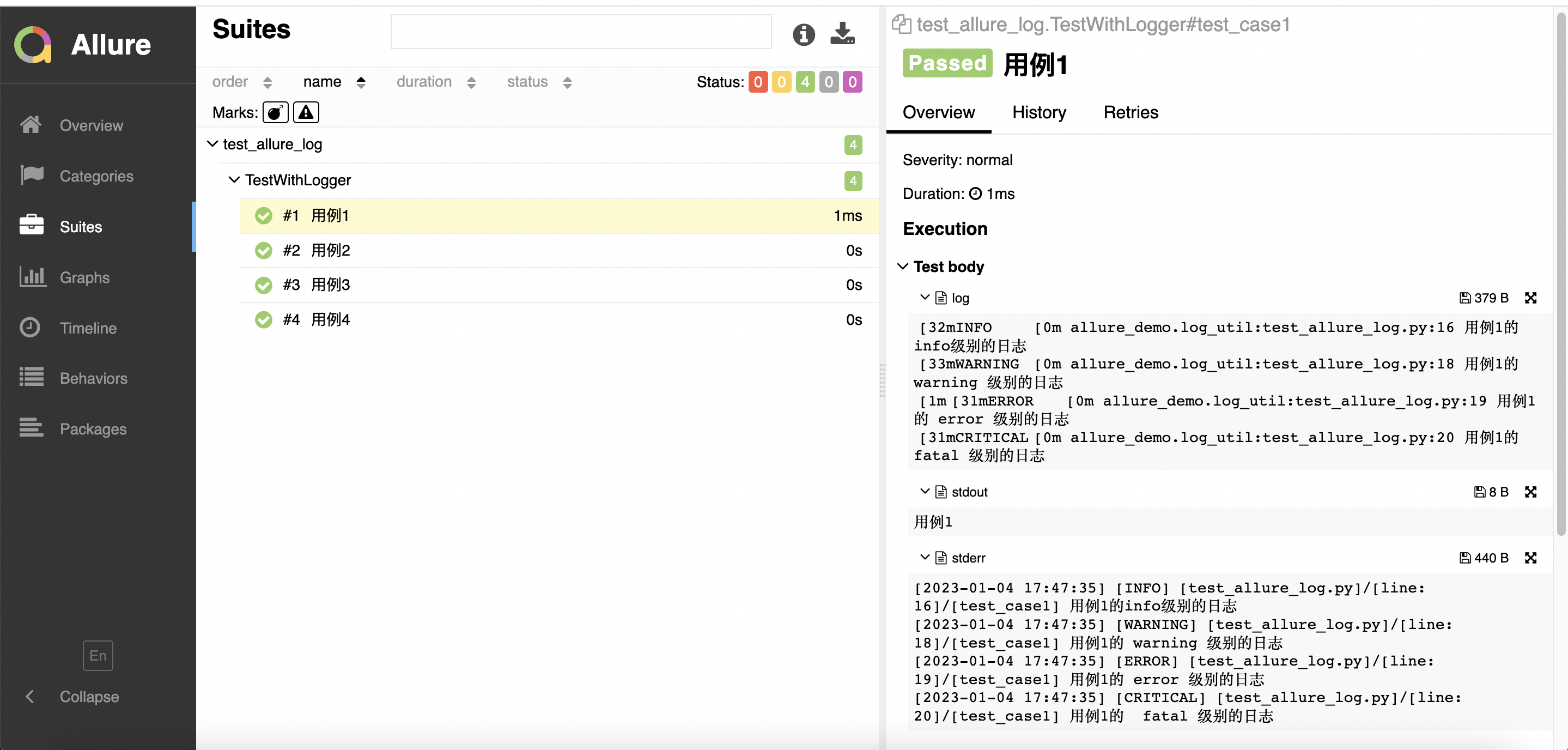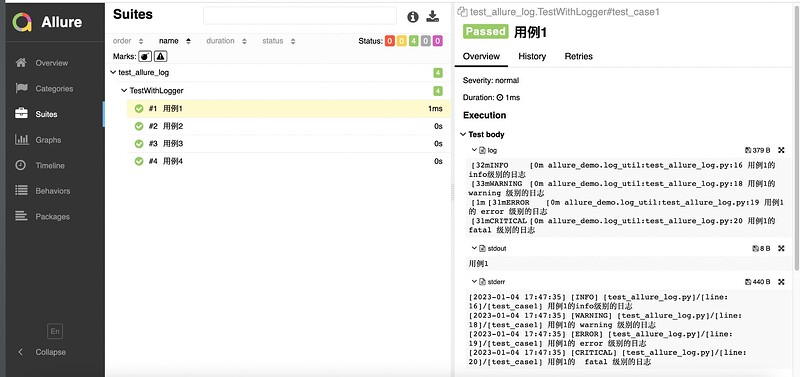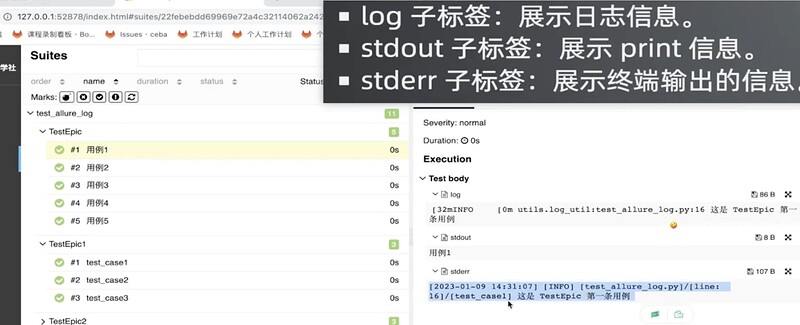Allure2报告中添加附件-日志
Allure2 报告中添加附件(日志)应用场景
- 应用场景:报告中添加详细的日志信息,有助于分析定位问题。
- 解决方案:
- Python:使用 python 自带的 logging 模块生成日志,日志会自动添加到测试报告中。
- Java:直接通过注解或调用方法添加。

Allure2 报告中添加日志 - Python
- 日志配置,在测试报告中使用
logger对象生成对应级别的日志。
# 创建一个日志模块: log_util.py
import logging
import os
from logging.handlers import RotatingFileHandler
# 绑定绑定句柄到logger对象
logger = logging.getLogger(__name__)
# 获取当前工具文件所在的路径
root_path = os.path.dirname(os.path.abspath(__file__))
# 拼接当前要输出日志的路径
log_dir_path = os.sep.join([root_path, f'/logs'])
if not os.path.isdir(log_dir_path):
os.mkdir(log_dir_path)
# 创建日志记录器,指明日志保存路径,每个日志的大小,保存日志的上限
file_log_handler = RotatingFileHandler(os.sep.join([log_dir_path, 'log.log']), maxBytes=1024 * 1024, backupCount=10 , encoding="utf-8")
# 设置日志的格式
date_string = '%Y-%m-%d %H:%M:%S'
formatter = logging.Formatter(
'[%(asctime)s] [%(levelname)s] [%(filename)s]/[line: %(lineno)d]/[%(funcName)s] %(message)s ', date_string)
# 日志输出到控制台的句柄
stream_handler = logging.StreamHandler()
# 将日志记录器指定日志的格式
file_log_handler.setFormatter(formatter)
stream_handler.setFormatter(formatter)
# 为全局的日志工具对象添加日志记录器
# 绑定绑定句柄到logger对象
logger.addHandler(stream_handler)
logger.addHandler(file_log_handler)
# 设置日志输出级别
logger.setLevel(level=logging.INFO)
Allure2 报告中添加日志 - Python
- 代码输出到用例详情页面。
- 运行用例:
pytest --alluredir ./results --clean-alluredir(注意不要加-vs)。
@allure.feature("功能模块2")
class TestWithLogger:
@allure.story("子功能1")
@allure.title("用例1")
def test_case1(self):
logger.info("用例1的 info 级别的日志")
logger.debug("用例1的 debug 级别的日志")
logger.warning("用例1的 warning 级别的日志")
logger.error("用例1的 error 级别的日志")
logger.fatal("用例1的 fatal 级别的日志")
Allure2 报告中添加日志 - Python
- 日志展示在 Test body 标签下,标签下可展示多个子标签代表不同的日志输出渠道:
- log 子标签:展示日志信息。
- stdout 子标签:展示 print 信息。
- stderr 子标签:展示终端输出的信息。
import allure
from utils.log_util import logger
@allure.epic("需求1")
@allure.feature("功能模块一")
class TestEpic:
@allure.story("子功能一")
@allure.title("用例1")
def test_case1(self):
logger.info("这是 TestEpic 第一条用例")
print("用例1")
@allure.story("子功能二")
@allure.title("用例2")
def test_case2(self):
logger.debug("这是 TestEpic 第二条用例")
print("用例2")
@allure.story("子功能二")
@allure.title("用例3")
def test_case3(self):
logger.warning("这是 TestEpic 第三条用例")
print("用例3")
@allure.story("子功能一")
@allure.title("用例4")
def test_case4(self):
logger.error("这是 TestEpic 第四条用例")
print("用例4")
@allure.story("子功能三")
@allure.title("用例5")
def test_case5(self):
print("用例5")
@allure.epic("需求1")
@allure.feature("功能模块二")
class TestEpic1:
@allure.story("子功能四")
def test_case1(self):
print("用例1")
@allure.story("子功能五")
def test_case2(self):
print("用例2")
def test_case3(self):
print("用例3")
@allure.epic("需求2")
class TestEpic2:
def test_case1(self):
print("用例1")
def test_case2(self):
print("用例2")
def test_case3(self):
print("用例3")
Allure2 报告中添加日志展示功能禁用 - Python
- 禁用日志,可以使用命令行参数控制
--allure-no-capture
pytest --alluredir ./results --clean-alluredir --allure-no-capture
Allure2 添加附件(日志)实现方法 - Java
Allure 支持两种方法: - 注解方式添加。 - String类型添加。 - byte类型添加。 - 调用方法添加。 - String类型添加。 - InputStream类型添加。
注解方式 - Java
- 日志文件为String类型。
@DisplayName("注解方法 - 文本添加验证")
@Test
public void testAllureWithTxtAttachment() {
//3.添加到注解中
attachTxtFile(文件读取为String);
}
@Attachment(value = "描述信息", type = "text/plain")
public static String attachTxtFile(String txtContent) {
return txtContent;
}
- 日志文件为byte类型。 ```java
public void exampleTest() {
byte[] contents = Files.readAllBytes(Paths.get("a.txt"));
attachTextFile(byte[]的文件, "描述信息");
}
@Attachment(value = "{attachmentName}", type = "text/plain")
public byte[] attachTextFile(byte[] contents, String attachmentName) {
return contents;
}
---
### 注解方式
* 注解方式且日志文件为byte[]类型。
public void exampleTest() {
byte contents = Files.readAllBytes(Paths.get(“a.txt”));
attachTextFile(byte的文件, “描述信息”);
}
@Attachment(value = “{attachmentName}”, type = “text/plain”)
public byte attachTextFile(byte contents, String attachmentName) {
return contents;
}
### 调用方法 - Java
* 日志文件为String类型。 `java Allure.addAttachment("描述信息", "text/plain", 文件读取为String,"txt");`
* 日志文件为InputStream流。 `java Allure.addAttachment( "描述信息","text/plain", Files.newInputStream(文件Path), "txt");`

